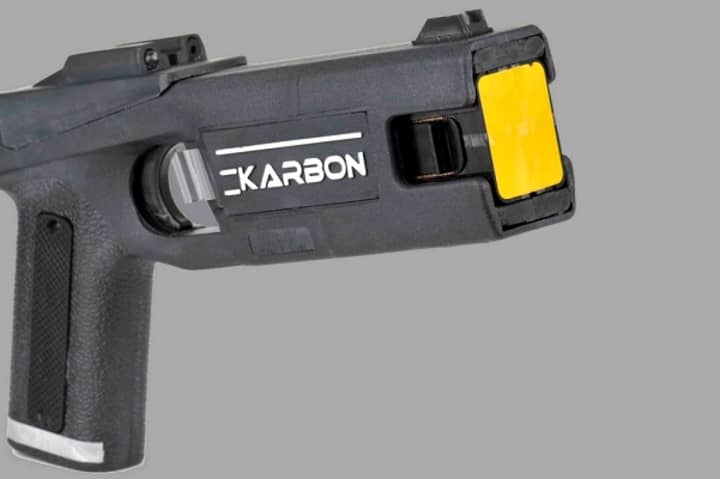Testing by the New Jersey State Police “called into question the reliability” of the Multi-Purpose Immobilization Device (MPID) made by Karbon Arms Inc., which was approved by his predecessor less than a year ago, Acting Attorney General John Hoffman said in a memo to all New Jersey police agencies.
“This suspension is effective immediately and will continue until further notice,” Hoffman wrote, adding that it was being done “to protect law enforcement officers whose departments have purchased these devices until the problems can be remedied.”
The attorney general said his staff met with representatives of Karbon Arms to discuss the “defects and failures” with the device before he ordered the suspension. The trouble came to light, he said, during separate training and qualification courses by the Burlington and Cumberland County prosecutor’s offices. State Police immediately were asked to test the devices, Hoffman said.
“The New Jersey Office of the Attorney General finds the defects and failures to be unacceptable In that they expose New Jersey law enforcement officers to an undue risk of harm,” he said.
Karbon Arms has “have requested the opportunity to cure the defects and have asked that they be given sufficient time to do so,” Hoffman said.
The company “will be required to submit MPID devices and associated equipment for re-testing by members of the New Jersey State Police (NJSP) Weapons and Tactics Unit” to determine whether specific requirements are met “before [it] will be considered for reinstatement, the attorney general said.
It’s unclear how many law enforcement agencies in the state already have purchased the KA devices.
New Jersey was the last state to approve use of the less-than-lethal weapons.
In turn, the state Attorney General’s Office enacted strict, comprehensive guidelines governing the use of the “conductive energy devices” considered the strictest in the nation.
For instance, an officer can use a stun gun only if he or she believes it’s necessary to:
- prevent someone from causing bodily injury to anyone involved, including himself/herself, the officer or someone else;
- prevent someone suspected of an assault or homicide from fleeing;
- get someone into custody who won’t submit even after repeated commands.
There is also an important distinction for citizens to consider: Under the Attorney General’s regulations, police AREN’T required to use a stun gun first when deadly force is required to stop an attacker. They have guns for that.
Most CEDs fire two darts that attach to the target and generate 50,000 volts in 5-second blasts. In many people, this overwhelm the body’s motor system, creating spasms or knocking them to the ground.
Certain other people, however, might become even more agitated if already enraged.
Small cameras are part of an array of data collection by the device every time it is used.
Under THE NJ ATTORNEY GENERAL’S GUIDELINES for stun-gun use:
- An officer must receive written permission from his or her chief and qualify using the weapon three times a year;
- Stun guns can be fired only when an officer believes such force is reasonably necessary to prevent serious injury or death, or to prevent the flight of someone who caused serious injury or death to someone else;
- An officer may not shock a person a second time unless the person still poses the same threat;
- An officer may not shock a person who is handcuffed or restrained unless the person poses an immediate threat of serious injury or death;
- An officer may not use a stun gun’s drive-stun mode, in which the weapon is directly pressed against a person, unless the person poses an immediate threat of serious injury or death;
- A stun gun can not be used against someone who is passively resisting an officer’s commands;
- A stun gun can not be used or threatened to be used as punishment or retaliation for a past action;
- A stun gun can not be used against someone driving a vehicle;
- Police cannot use more than one stun gun on a person at the same time;
- When possible, an officer should warn a person that a stun gun is about to be used;
- An officer can not not remove the stun gun from its holster unless the situation likely calls for its use;
- An officer should not fire a stun gun when it could strike an innocent bystander — unless it is necessary to protect the bystander from serious injury or death;
- Whenever possible, officers should use stun guns only when another officer is present who is capable of shooting the attacker to prevent serious injury or death;
- Stun guns can not be used in an area where there are flammable gases or liquids that could ignite from a spark or near a body of water into which the target could fall;
- Officers should “use particular care” when considering the use of a stun gun on an elderly person, child, or anyone with a known medical condition, such as a pregnant woman;
- Anyone hit by an officer’s stun gun must be taken to a medical facility for examination;
- Every time a stun gun is used, that officer’s superior must investigate and report on the incident to the county prosecutor’s office.
PHOTO: Courtesy KARBON ARMS INC.
Click here to follow Daily Voice Northern Valley and receive free news updates.


